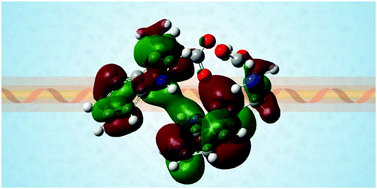The structures and properties of anionic tryptophan complexes†
Abstract
The physicochemical properties of [Trpn–H]− and [Trpn⋯Cl]− (n = 1, 2) have been investigated in a combined computational and experimental infrared multiple dissociation (IRMPD) study. IRMPD spectra within the 850–1900 cm−1 region indicate that deprotonation is localized on the carboxylic acid moiety in [Trpn–H]− clusters. A combination of hydrogen bonding and higher order charge–quadrupole interactions appear to influence cluster geometries for all investigated systems. Calculated global minimum and low energy geometries of [Trp⋯Cl]− and [Trp2⋯Cl]− clusters favour coordination of the halide by the indole NH. [Trp2–H]− and [Trp2⋯Cl]− exhibit additional π–π interactions between the heterocyclic side chains.



 Please wait while we load your content...
Please wait while we load your content...